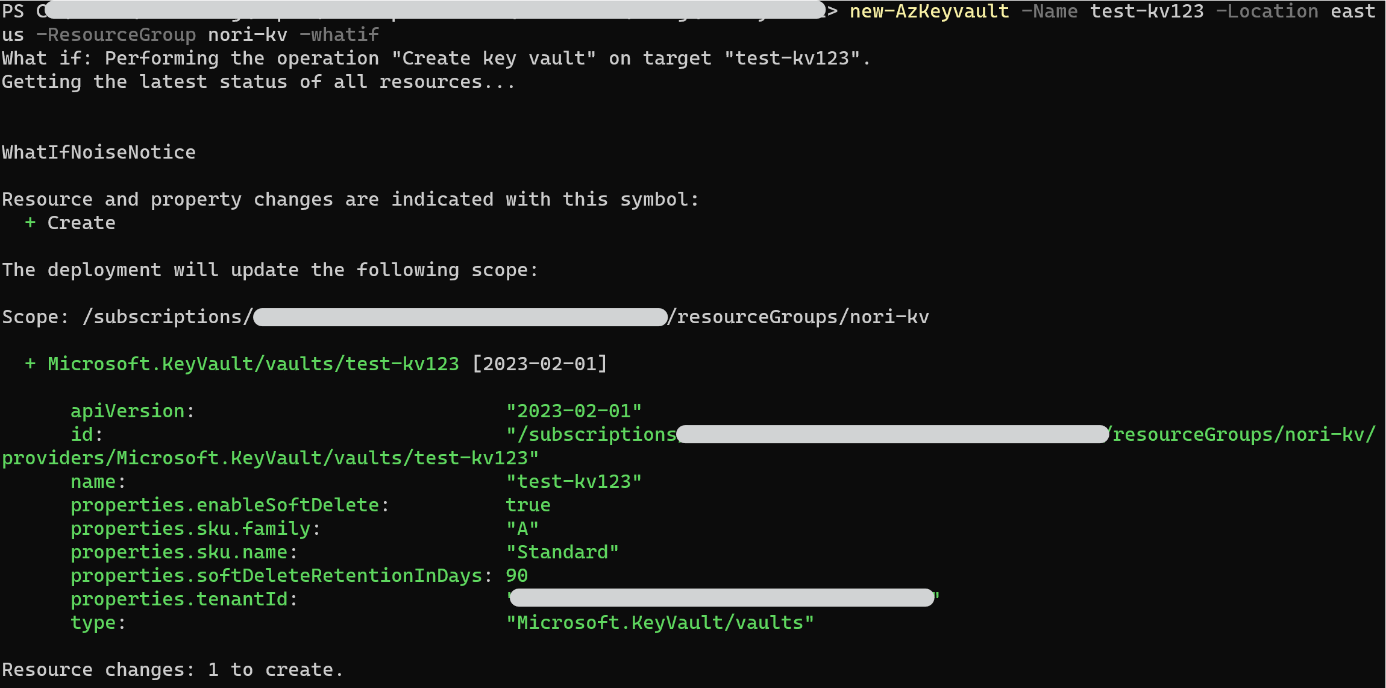Announcing template-based previews of Azure CLI and Azure PowerShell for Key Vault deployments

We are announcing the new implementation of Azure CLI and Azure PowerShell commands to create Azure Key Vault.
Advantages
We leverage the ARM template mechanism to refactor the Key Vault command line. Compared with the previous implementation, calling REST API through SDKs, this implementation scheme has the following advantages that users can benefit from.
- Consistency. Ensure consistent behavior and defaults between Azure CLI, Azure PowerShell, and Portal.
- What-If. Support a ‘what if’ option to predict the impact of a deployment before the command is executed.
- Idempotency. Sending the same request multiple times will produce the same result, regardless of resource state.
What’s new
We implemented several new features when compared to the previous version of commands.
What-If
What-If is designed to show users as much information about what their deployment will do before it deploys.
Progress Bar
We have implemented a progress bar to visualize the deployment.
Idempotency
We are using the incremental mode of ARM deployment to create key vaults. By setting –FailOnExist as $false, we can repeatedly create the same key vault or update the existing one.


Deep Dive
For Key Vault creation, Azure Client Tools previously followed a different structure than Azure Portal, as shown in the following example:
With the ARM template included, we maintain consistency and communicate directly with ARM:
We are using template specs to make staging and sharing of ARM templates easy.
Next Steps
We look forward to your feedback. We will evaluate the effects and risks and consider expanding the command line scope of service, module, and extension.
Getting Started
You can test our new version by following the instructions provided below. Your feedback will help shape the strategy of how we build the command line tools for Azure.
Getting started with Azure PowerShell
The PowerShell package for private preview is provided on the PowerShell Gallery.
Installation
Copy and paste the following command to install this package using PowerShellGet:
Install-Module -Name Az.KeyVault -RequiredVersion 4.12.0-preview -AllowPrerelease
Quick Start
Getting started with Azure CLI
The CLI package for public preview is provided as MSI / whl packages:
For MSI package Installation
Download and install the MSI package. When the installer asks if it can make changes to your computer, select "Yes". If you have previously installed the Azure CLI, make sure it has been uninstalled first.
For whl package Installation
- Prepare and use a separate virtual environment
# Create a python virtual env named `testenv` with: python -m venv testenv # Activate the env (if you are using powershell): .\testenv\Scripts\Activate.ps1 # Activate the env (if you are using bash): source venv/bin/activate - Unzip and install private .whl packages
# Unzip the file and install three cli whl packages (azure_cli, azure_cli_core, azure_cli_telemetry) pip install azure_cli-2.53.0.post20230920063357-py3-none-any.whl azure_cli_core-2.53.0.post20230920063357-py3-none-any.whl azure_cli_telemetry-1.1.0.post20230920063357-py3-none-any.whl
Quick Start
For whl package clean up
Feedback
This feature is already available. Feel free to share your experience by participating in our survey. We welcome your feedback!
Published on:
Learn moreRelated posts
From Backlog to Delivery: Running Scrum in Azure DevOps
This is a practical, end-to-end guide to run Scrum with Azure DevOps — from backlog grooming through sprint delivery and continuous deployment...
Azure SDK Release (November 2025)
Azure SDK releases every month. In this post, you'll find this month's highlights and release notes. The post Azure SDK Release (November 2025...
Microsoft Purview: Information Protection-Azure AI Search honors Purview labels and policies
Azure AI Search now ingests Microsoft Purview sensitivity labels and enforces corresponding protection policies through built-in indexers (Sha...
Soluzione Earns Microsoft Solutions Partner Designation for Data & AI (Azure)
Soluzione has been a Microsoft partner for over a decade – a journey that began with Microsoft Silver Partnership, progressed to achieving Mic...
What’s New with Microsoft Foundry (formerly Azure AI Foundry) from Ignite 2025
Microsoft Ignite 2025 just wrapped up, and one of the biggest themes this year was the evolution of Azure AI Foundry, now simply called Micros...



